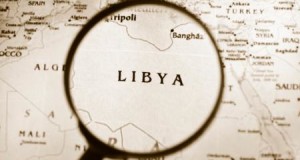The Pentagon and US intelligence community are weighing what is referred to as an “Al-Sisi Option” for Libya, as the June 17 deadline for a United Nations-brokered cease-fire and unity government deal nears, with no sign of a diplomatic breakthrough. The United Nations Support Mission in Libya, headed by Bernardino Leon, has been trying to win support for a deal between the Tobruk-based recognized elected government, and the Tripoli-based Libyan Dawn coalition, which seized the capital and has governed the western half of the country since last year.
While the United States is formally backing the United Nations initiative, the Pentagon and CIA are putting in place a contingency to install General Khalifa Haftar as the Libyan head of state, if the talks fail. Up until now, the US policy has been to provide sufficient weapons to General Haftar’s forces to keep up pressure on the Tripoli-based, Muslim Brotherhood-dominated Libyan Dawn, and to covertly encourage breaks by regional tribes and militias from the Tripoli faction, to force them to the table.
If the June 17 deadline passes with no deal, the Obama Administration is reportedly prepared to go all-out to finance General Haftar to carry out a full-scale military operation against Libyan Dawn and allied jihadist factions, including the Islamic State and Ansar Al-Sharia. Washington is satisfied that General Haftar is capable of establishing security control over the country over time, and would be a loyal ally of Washington. Pentagon officials pushing the Haftar military takeover, if the negotiations fail, argue that he would be a capable head of state, closely allied with Egyptian President El-Sisi, who came into power in the wake of mass protests against the failed Muslim Brotherhood rule of Mohammed Morsi. “It’s the El-Sisi Model that the Pentagon is promoting,” one US retired military official confirmed.
The Libya crisis has been compounded by the fact that some of the jihadist factions have allied with criminal gangs that run a vast human trafficking ring between Libya and southern Europe. The recent sinking of one of the smugglers’ ferries, killing an estimated 1,000 refugees, triggered a fierce public debate within the European Union. This week, the EU announced plans to provide surveillance drones to the Tobruk government in Libya, to facilitate European Union plans to shut down the smuggling routes, through targeted military operations. In 2014, an estimated 220,000 North African refugees fled by smuggler ships to Europe, creating a backlash against the flood of immigrants arriving on the Mediterranean shores of Europe. As many as 20,000 people drowned during those crossings. Unless a successful crackdown is launched, an estimated 300,000 more African refugees will land in Europe, with more than 30,000 expected to die en-route.
General Haftar is well-known to the Pentagon and the CIA, having been brought to the United States in 1990, after he defected from Muammar Qadaffi, after having helped overthrow King Idris in the late 1960s. General Haftar was sent back to Africa in 1996 as part of a failed CIA coup attempt against Qadaffi, and he returned again in 2011, when the Benghazi revolt first erupted.
Last year, General Haftar, with backing from Egypt and the United Arab Emirates, along with cautious support from Washington, launched a military campaign against the Muslim Brotherhood-backed Tripoli Libyan Dawn insurgents. In March 2015, he was named as head of the armed forces aligned with the Tobruk government.
Libya has proven to be a tremendous embarrassment for the Obama Administration, which portrayed the overthrow of Qadaffi as a “humanitarian intervention” and claimed to have only played a marginal role, preferring to “lead from behind.”
President Obama is now facing further embarrassment, with the release, this week, of a Defense Intelligence Agency (DIA) document, dated September 12, 2012, which provided a detailed account of the previous day’s assault by jihadist forces against the US mission and CIA annex in Benghazi, which resulted in the killing of US Ambassador Christoper Stevens and three other American diplomats. The September 12, 2012 DIA document, which went to the National Security Council (NSC) as a primary recipient, identified the Derna-based Brigades of the Captive Omar Abdul Rahman (BCOAR) as the group behind the assault, and detailed that the planning for the attack had begun on September 1, 2012, and was aimed at avenging the killing of a top Al Qaeda official of Libyan birth, and “memorializing” the September 11, 2001 attacks on the World Trade Center buildings on the anniversary of that original attack.
President Obama and then-United Nations Ambassador, now National Security Advisor Dr. Susan Rice, both claimed for weeks after the attacks that the assault on the Benghazi compounds was a “spontaneous” action, protesting a video that slandered the Prophet Mohammed. President Obama, in the midst of his re-election campaign, did not wish to acknowledge that Al Qaeda still was a serious threat, following the killing of Osama Bin Laden.
 Geostrategic Media Political Commentary, Analysis, Security, Defense
Geostrategic Media Political Commentary, Analysis, Security, Defense





